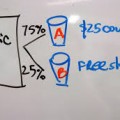These days, there’s a great deal of focus on organic search results in the Google SERPs, at least in the West. In much of Asia, more effort may be place on ranking with Baidu, while central and eastern Europe is normally more focused on Yandex.
In North America, Bing and Yahoo are players to be considered, too. Although Google commands more than twice the search traffic that Bing, its closest competitor, does, Bing can be very effective for bringing in search traffic in some niches. I see people reporting better conversion rates on their Bing traffic all the time.
For paid ads, some companies aren’t in a position to make significant investments with both Google and Bing, so they often put their money where they think it will do the most good. This isn’t always as simple a decision as it may seem, though. Mere traffic numbers aren’t necessarily enough to make the right call.
Traffic is important, provided it’s convertible traffic. Visitors that buy nothing aren’t worth paying for, when sales is your site’s goal. So it’s important to look at more than just how much traffic you’re receiving from each search engine.
Obviously, your conversion funnel should be tuned up before you even start spending money on bringing in traffic. Assuming that’s already in order, there are two basic ways to look at the effectiveness of your promotional efforts:[list type=”bullet4″]
- number of sales divided by the number of visitors
- cost per sale
[/list]
There are a number of factors that can enter into a thorough analysis of your advertising, but these two are at the heart of it.
Avoid Misguided Logic
Of course, all our traffic doesn’t come from paid ads. Organic search is usually a big slice of the pie. Let’s say you’re receiving an average of 3600 unique visitors per day from organic search, and an average of 42 sales each day from those. That means you have a 1.17% conversion rate.
But breaking it down, if you’re getting 2,400 unique visitors per day to your site from Google search, and seeing 24 sales from them, that equates to a 1% conversion rate for your Google traffic. You’re only seeing 1,200 unique visitors per day from Bing search. But that 1,200 turns into another 18 sales.
In terms of sales volume, 24 sales is 25% more than 18, so that probably already would have gotten your attention. Who would be prepared to ignore a source that could deliver 25% more sales? But looking at the aggregate in this example, Bing would be bringing in nearly 43% of your sales. You definitely would pay attention to that, wouldn’t you?
Now let’s look at it another way… your conversion rate for the traffic from Bing is 1.5%… 50% more than what Google sends you. That should be interesting for a couple of reasons.
First, if you can figure out why Bing traffic converts better, you’ll be in a better position to take advantage of it – perhaps you can improve it, perhaps you can learn something you can apply on Google.
That can be difficult to do with strictly organic results. Some things you might look at, though, are whether you’re ranking significantly higher with Bing, and if the titles and snippets being displayed in their SERPS are more effective, as compared to those displayed on Google.
Second, if you plan to take measures to increase traffic from one or the other, the 1.5% conversion makes a lot more sense than 1%. Ideally, of course, you’ll simultaneously take action to improve your rankings with Google, and fine-tune your conversion some more.
If you’re presently pursuing only organic search traffic, but are considering paid advertising, that’s an entirely different process, with its own set of analytical processes. But regardless, organic search is almost certainly going to continue to be a part of your business, so it pays to analyze and optimize.
Remember, traffic takes time to build, but improvements to your conversion funnel can have immediate results. You should always focus first on converting the traffic you have, then go after more visitors. It pays off faster, and it’ll work on the new traffic, too.



